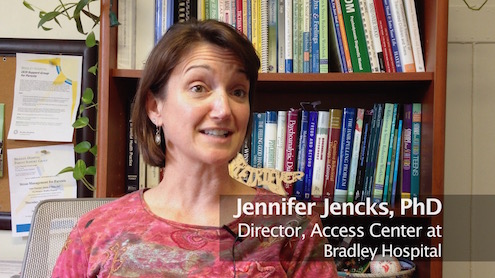Understanding Childhood Fears
Can you remember being afraid of the bogey man? Couldn't sleep without a night light? It seems that childhood fears have always been part of growing up.
Experts from Bradley Hospital offer information to help you better understand your child's fears.
Does the type of fear vary by age group?
Absolutely. For young children, the underlying fear of separation from the primary caregiver is most often the catalyst for early childhood fears.
Many common fears in young children, such as being afraid of the dark, stem from anxiety over being separated from one or both parents. Nighttime is a time of uncertainty for children because it is the only time they are entirely alone. Without the presence of a parental figure, a child may not feel entirely safe or secure. The dark is only one of various fears that can stem from separation anxiety. The fear of a parent getting hit by a car is the most common.
Young children also fear the unfamiliar and the unknown. For young children who are just beginning to organize the world around them, monsters are still in their realm of possibility. They are not entirely sure of what exists and what does not, so their imagination can create incredible things.
Older children learn to separate the real from the fictional. They begin to develop more socially-oriented or abstract fears. Older children become concerned about peer opinion, popularity, bullying or failing classes.
Why do childhood fears develop?
There is no single answer for why fears develop. Fears can stem from genetics, socialization or behavioral conditioning.
Early research appeared to indicate that phobias were behaviorally conditioned. For example, if a child is bit by a dog, their chances of fearing dogs increases. However, more recent studies suggest that many people are born with unusually responsive or sensitive temperaments that put them at risk for anxieties and fears.
Parents can help
For children of all ages, it is important that parents acknowledge anxieties and fears. Be understanding. Do not abandon an upset child. Instead, talk them through it. Most importantly, convey your confidence that they are capable of not only handling this fear, but overcoming it. It is essential that your child believe you are confident in their abilities to handle situations. If you seem worried, they will become increasingly anxious. Teaching confidence will go a long way in combating fears.
For younger children, routine is the key. Bland, repetitive routines encourage a feeling of security. If your child is afraid of the dark, ensure that bedtime is a monotonous, non-exciting time. Every night at a specific time your child should do the same activities in the same order. For example, they should know that every night at 7 p.m. they take a bath, brush their teeth, read a book and go to bed. Since many fears are manifestations of separation anxiety, calming routines will help your child feel safe and protected.
At what point should a parent be concerned?
Parents are encouraged to use their common sense and parental intuition to assess whether a fear warrants real concern. Observe other children and see if your child appears different from others in their age group. Feel free to ask other parents their viewpoints. If a child is past the age where it is developmentally normal for them to be afraid of something, for example, monsters, it may be time to consult a pediatrician.
The most important indicator that a fear has reached a concerning or phobic stage is that it is interfering in the child's everyday ability to function.
Some fears never entirely disappear. Adults may revert back to fears from childhood during particularly stressful times in their lives. Again, this becomes abnormal when a person is no longer able to function normally. But, in general, childhood fears are a normal occurrence that are overcome with age.


